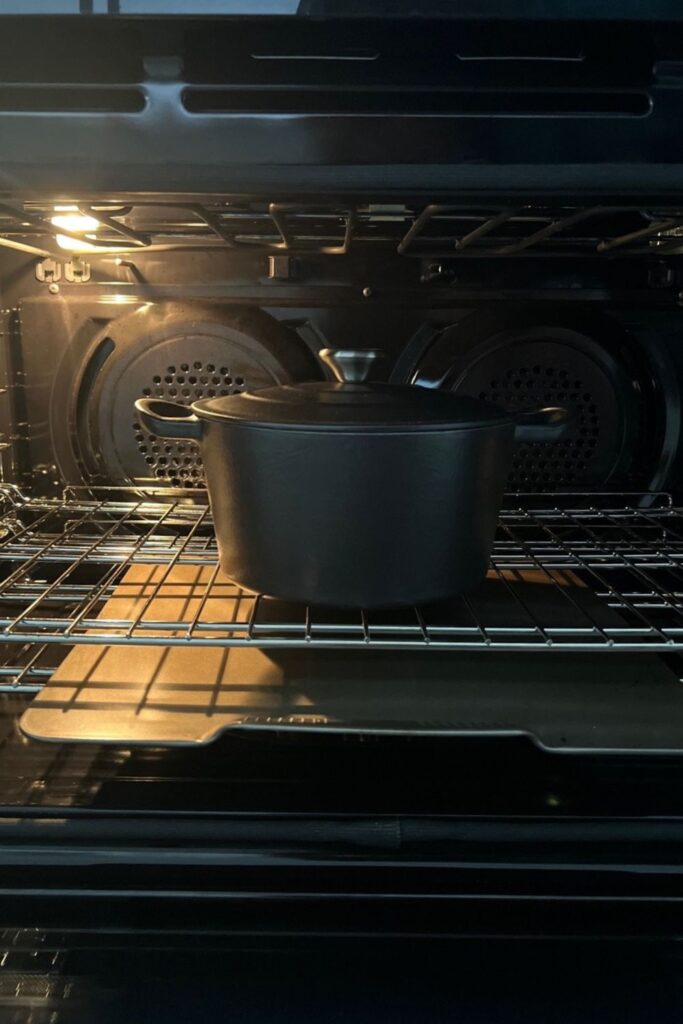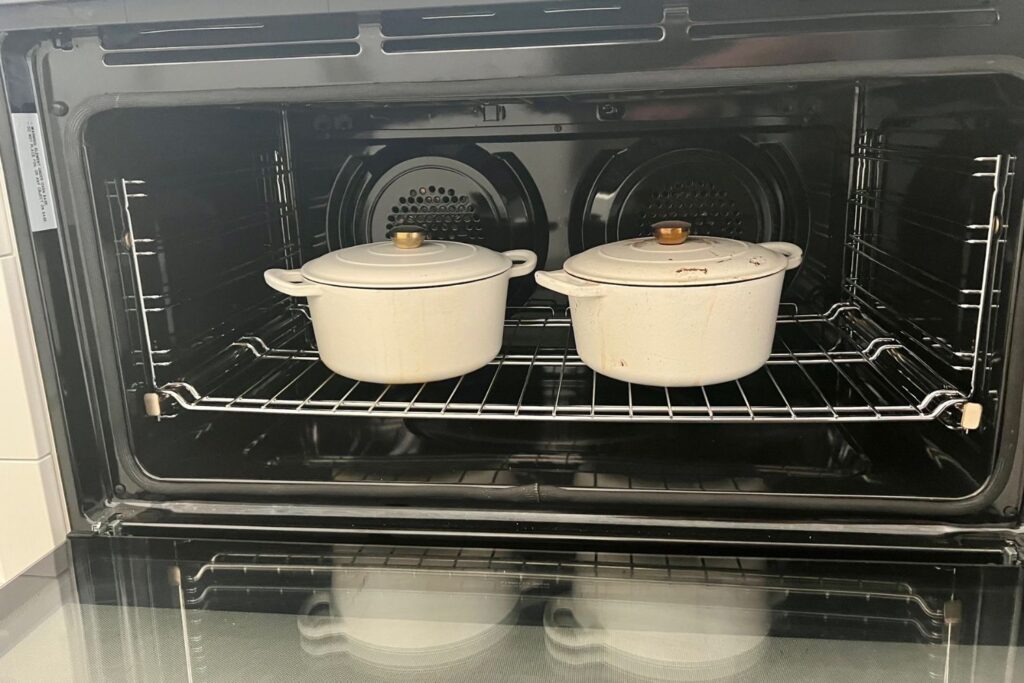Want to stop burning the bottom of your sourdough bread burning every time you bake? I've put together some easy ways to ensure you get perfectly baked sourdough bases every time! No more burnt bottom or thick or chewy crusts on your next sourdough loaf!
If you love using your sourdough starter to bake the perfect loaf of sourdough, you're going to love all of these tips for perfecting the bottom of your artisan sourdough bread. It's actually one of the most common issues faced by home bakers when embarking on their sourdough journey.
My top 10 ways for preventing the base of your sourdough from burning are:
- Place a baking tray underneath your Dutch Oven
- Line your Dutch Oven with parchment paper
- Use a trivet inside your Dutch Oven
- Utilise cornmeal, rice or rolled oats
- Reposition your loaf
- Lower the overall temperature
- Consider an open bake
- Use less sugar in your recipe
- Mist your dough or use ice to reduce surface temperature
- Use lighter colored bakeware
If you're looking for some new sourdough bread recipes, why not try this chocolate chip sourdough bread, this small batch sourdough loaf or even this orange and cranberry sourdough bread. They're all guaranteed to tantalise your taste buds and give you great results! I recommend using a kitchen scale and weighing your ingredients, as well as using good quality bread flour rather than all purpose flour for a better quality bake.
Why Does The Bottom of Your Sourdough Burn?
The two main reasons your sourdough bread burns on the bottom of the loaf are:
- the bread dough is in direct contact with the bottom of the Dutch Oven
- there is more heat being directed at the base of your dough than at the top
Sourdough bread is generally baked at high temperatures which increases the likelihood that some part of the loaf will burn. The base of the loaf is often the first part to burn, with the ear of the sourdough coming a close second.
The good news is there are lots of ways to prevent the base of your sourdough from burning.
How Do I Stop My Sourdough From Burning on the Bottom? (10 Tips)
There are actually lots of different ways to stop your sourdough loaves from burning on the bottom. Choosing the method that works for you can really depend on your method of baking, the ingredients in your loaf and the temperature you're baking your sourdough at.
You're sure to find a method that works for you from the ones I've listed below - all tried and tested in The Pantry Mama Kitchen!
Place A Baking Tray Underneath
Placing a baking tray on the rack beneath your Dutch Oven insulates the base of the pot and protects it from too much heat, thus preventing the base of your sourdough from burning. It lowers the heat transfer underneath your bread.
To achieve optimal oven spring, sourdough and other artisan breads need a very hot oven - sometimes up to 260 degrees Celsius (500 degree Fahrenheit). At these temperatures, it’s not hard to burn the bottom of your bread.
This can affect the aesthetic of your loaf when it’s cut open and cause the crust on the bottom to be black, tough and way too thick.

Use Baking Paper Between Your Dough & Dutch Oven
Baking your sourdough bread directly in a Dutch Oven with no parchment paper can make it easier for your bread to burn because there is nothing protecting the base of your bread. Using parchment paper can also help to transfer the dough from your banneton to the Dutch Oven with minimal effort.
Using a more expensive parchment paper is a good investment because cheaper parchment paper often breaks and disintegrates at high heat.
A silicone mat can also be used as an alternative to parchment paper.

Use A Trivet Inside Your Dutch Oven
If you are having trouble with the bottom of your sourdough burning, even if you are using parchment paper, using a trivet at the base of your Dutch Oven is a good idea. This stops the sourdough having direct contact with the base of the pot, which is often the hottest part. A trivet like this perfect.
If you can't find a trivet to fit in the bottom of your Dutch Oven (or you are doing sourdough on a budget), a piece of scrunched up aluminum foil will do the job nicely.
But remember you'll still need to use a piece of parchment paper to ensure your bread doesn't stick to the aluminum foil. So you would lift your dough into the Dutch Oven as per normal, but place it on top of the trivet, so the parchment paper protects the bottom of your loaf from baking into the trivet.
If you don't want to use parchment paper, a silicone baking mat will work.

Use Cornmeal, Rice or Rolled Oats
Using cornmeal, rice or rolled oats is another technique to insulate the bottom of your bread from sitting directly on the base of your cook ware.
You'll still need to use parchment paper though, not only to transfer your loaf safely to your Dutch Oven, but also to stop the cornmeal from sticking to the base of your bread.
Cornmeal probably isn't so bad, but you don't want uncooked rice baked into the bottom crust of your sourdough. It works well with parchment paper though.
Reposition Your Loaf
Sometimes all you need to do is reposition your loaf within your oven. It's a good idea to understand where the heating element is in your oven (or if there are multiple heat sources) and how the racks are configured.
Moving your loaf further away from the direct heat source can certainly help to stop the base of your sourdough bread burning. It will be harder to do this in a smaller oven or if the heat source is at the bottom of the oven, so you may need to incorporate other techniques like adding ice or the baking sheet trick above.
Most home oven allow you to move the oven racks easily when the oven is turned off.

Lower the Overall Temperature
Often sourdough recipes suggest extremely high oven temperatures for baking loaves, some as higher than 500F (260C). If the base of your loaf is burning at this temperature, it's totally fine to lower the overall temp of your bake. My simple sourdough recipe suggests the initial baking temperature to be 450F (230C). This is high enough a temp to promote good oven spring and a crackling, crispy crust - without burning the bottom of your loaf (or the top of the loaf!).
If you feel your oven temperature may be a little off, it's a good idea to invest in an oven thermometer that has been properly calibrated and can independently measure your oven temperature.
Sometimes factors like worn oven door seals and the age of your oven can mean that the temperature inside your oven is different to what is shown on the oven's thermostat.
Consider an Open Bake
If you are really having trouble with a burnt bottom when you're baking in a Dutch Oven, then you may need to consider an open baking method. This means baking the sourdough without a Dutch Oven and creating the steam you need from other sources.
Not using a heavy cast iron Dutch Oven can help to avoid burning the base of your loaf. Of course, if you are using a baking stone or pizza stone, a burnt bottom could still occur.
I find that using a baking tray lined with parchment paper is an effective open bake method. Adding a pizza stone and or baking stone to the bottom rack in the oven can help to regulate the heat better in this situation.
Use Less Sugar in Your Dough
Enriched dough, made with sugars (and milk and fats) are more prone to burning than lean doughs (dough made with just flour, water and salt). In fact, dough with honey, maple syrup or sugar will generally burn much faster, even if you don't increase the bake time or oven temperature.
Using ice cubes in the Dutch Oven can help with this issue, but generally, using less sugar is the key to preventing a burnt bottom in enriched doughs.
If you are baking a honey oat loaf or even a cinnamon raisin, you need to protect the base of the bread - and I recommend using a trivet for these doughs.
Mist The Dough To Reduce Surface Temperature
Misting the surface of the dough or adding ice to the Dutch Oven before putting it into a hot oven can help to reduce the surface temperature of the Dutch Oven, reducing the risk of the bottom of the loaf burning. It can also have other benefits like better oven spring and a blistered crust.
You do need to exercise caution when adding ice to a hot Dutch Oven (due to the risk of shocking the cast iron). You also need to make sure not to add too much ice which can actually lead to a soggy bottom and gummy outer crust. You can find a full guide to adding ice to sourdough here.
Use Lighter Color Bakeware
Choosing a lighter color enamel Dutch Oven can reduce the risk of burnt bottoms because it absorbs less heat than a darker color or raw cast iron. Most of my cast iron pots are cream enamel and when I use these, my sourdough loaves never burn on the bottom.

As you can see from this list, there are loads of options - and combinations - that you can use to stop your sourdough burning on the bottom. You just need to experiment to find the solution that works best for you and your oven configuration.
Frequently Asked Questions
Is a convection oven better for sourdough?
Not necessarily. Many convection ovens channel the air from the bottom to the top, meaning that the hot air makes contact with the bottom of the loaf first. To prevent this, you need to turn off the convection function of your oven for sourdough bread baking. It may be more energy efficient for some foods, however, for sourdough, it can be a problem. If you wish to continue to use convection heating, you'll need to use a heat insulator (like a baking sheet) to reduce the effect of the bottom to top airflow.
How do you get rid of the burnt bottom of bread?
If you do have a sourdough loaf that becomes a bit too dark on the bottom, one of the easiest things to do is slice the loaf as you normally would, but slice off the base crust before you eat or toast it. It's much easier to do this one slice at a time - as opposed to slicing off the base as a whole.

